Arcana and Fictif enthusiast. Also interested in dabbling in dark academia and other old timey things. I'm new to Tumblr so please don't hesitate to message me if you're interested in being friends. Eng/Indo (and maybe a little bit of Korean)
Don't wanna be here? Send us removal request.
Text

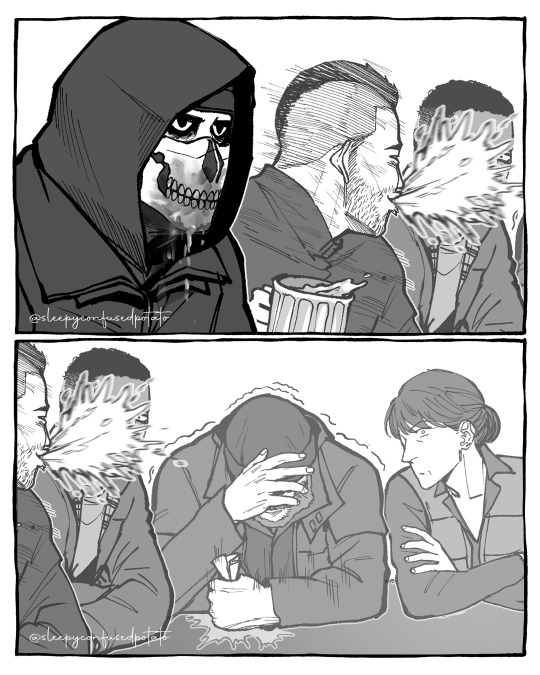
Ghost forgets he wears a mask sometimes.
The remastered version of the OG prompt because that ending REALLY sets the fucking scene.
I'm sorry Gaz.
26K notes
·
View notes
Text
On clothing/accessories/design elements of Liyue Characters
Just some things that I’ve noticed throughout the game and how they incorporate Chinese culture/references. This might be helpful if you are looking to understand some cultural context regarding the game. (Image heavy post. Also Idk how to format… Someone teach me pls…)
For regular citizens + NPCs, the clothes that they wear look to be based off of Qing Dynasty fashion and post-eras (early-mid 1900s). Therefore, it is very likely that the setting is based off of this particular timeline.
Tea Master Liusu as well as Childish Jiang wear a changshan which is the male equivalent of a cheongsam. It was a style introduced in late-Qing and became popularized post-Qing.



Qiming wears a long-sleeved cheongsam (I say cheongsam because the hem of her outer layer is long, which falls more in alignment with the stylization of a cheongsam) while Ying’er wears something that looks more like an early 1900’s Qing outfit. (Kind of hard to tell given that Genshin developers took liberties with her outfit, but this is based primarily off the silhouette and her collar. She does NOT wear a cheongsam or equivalent.)


Ningguang, however, is probably the easiest example of a cheongsam-influenced dress. This leads me to believe that Liyue clothing and customs are probably most likely based off of (late) Qing-dynasty to early-mid 1900’s dress. (Personal opinion but I find it interesting how she’s the only female who wears an obvious cheongsam and given her stance on Liyue’s modernization vs. the traditional way. But that’s neither here nor there.)
(A very good reference is by nannie on tumblr here: nannaia.tumblr.com/post/42640184651/)
We have NOT seen any older (”popular”) styles such as the ruqun nor hanfu from previous dynasties. (So if you’re going for an Liyue OC, it’s probably best to base them with Qing/post-Qing styles!)
Qiqi is based off of the jiangshi, which is already quite known from what I’ve seen. Basically they are “Chinese living dead” or zombies. She even wears the hat and the amulet over her head! (Traditionally, jiangshi also wore Qing outfits as they were popularized during that era!! Even if Qiqi’s is a definitely very stylized outfit!)

Ningguang wears nail guards with were an actual thing in Ancient China. Once again, another reference to Qing dynasty fashion! Guzhuangheaven goes more in depth in this post (guzhuangheaven.tumblr.com/post/182597279835/) but they were essentially a status symbol and not worn typically worn on all five fingers. (Typically two at most.)
This was because long nails were meant to indicate that the person did not need to work hard/do manual labour and therefore indicated their (higher) status. Nail guards were then introduced to protect those nails as well.
Zhongli wears two thumbs rings. Unlike in the west where rings were popularized as a symbol of marriage, it was not the same in Ancient China. In particular, the fact that Zhongli wears them on his thumbs — while can very likely be a design element — can be related to archery rings.
Archery rings were meant to protect the thumb from coming into harm upon pulling the bow string. The fact that he wears them on both hands probably implies that he is ambidextrous and that he is a very skilled archer!
As I am not a member of Genshin’s design team, pls do not take my word as law! These are just some interesting design choices that I’ve noticed and thought were interesting, and give a bit of insight onto cultural context.
I hope this provides some assistance to those who are interested in the design of (some) Liyue characters.
243 notes
·
View notes
Text
Book review: Chinese Wallpaper in Britain and Ireland (2017) by Emile de Bruijn

*I wrote this last year but completely forgot to post it. Enjoy the old stock :)
I’ve seen a lot of interesting images from this book on Pinterest so I decided to get the real thing, and I have to say I am extremely satisfied with it. This book is about Chinese made wallpapers from the Qing Dynasty (mostly 18th and early 19th centuries) that were exported to Europe and used as decoration in British and Irish homes. Although wallpapers are an interesting subject on their own, I will only be reviewing it only on the basis of how useful it is for fashion history research. This will be a short one.
Great images
Apparently I was not the only person who got this book for the pictures as the review at the back of the book suggests, and I fully understand why. This book contains high quality photos of Chinese wallpapers from the 18th and 19th centuries, in perfect resolution and colors. Even if you’re not interested in Chinese fashion, I would still recommend you to get this book because it also shows beautiful antique British and Irish interiors and chinoiserie wallpapers, and is just plain pleasant to look at.
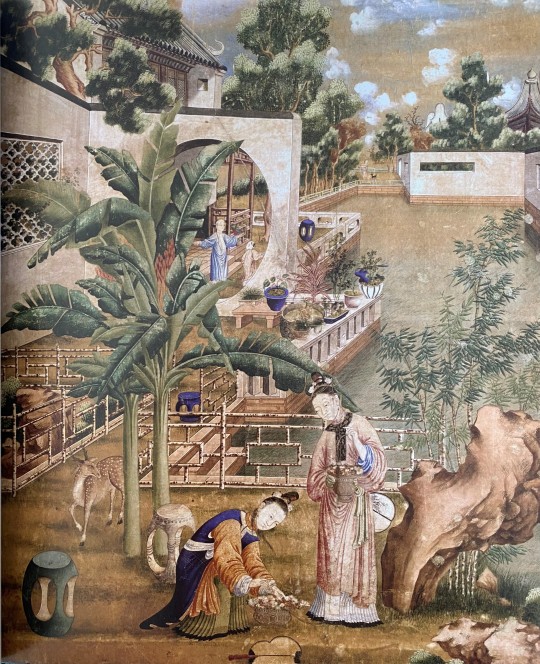
One of my favorites from the entire book, a full page spread with delicious details of a wallpaper depicting a Chinese garden using linear perspective. Even better that the ladies are clad in Qianlong era garments.
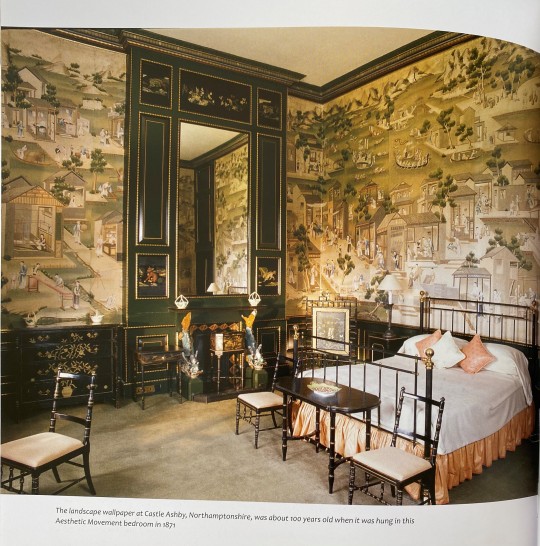
Photos of interiors are also immaculate.
The importance of commercial art
Commercial art like wallpapers, portraits and export paintings is very marginalized in the study of Chinese art, so I highly appreciate that this book sheds more light on a category that traditionally finds absolutely no favor with Chinese art historians. Because of commercialization and increased trade with Europe, popular artworks from this era that depicted life realistically often employed Western painting techniques at least to some extent, meaning they don’t look very Chinese and are often neglected by scholars; more stereotypically Chinese literati painting genres, such as landscape painting or 仕女画 shinvhua (idealized paintings of women) are definitely way more popular among art historians.
Literati painting seldom, if ever, depicted people’s clothing realistically. Costumes were meant to be excessively flowy, adhering to people’s imagination of deities and supernatural beings. Sometimes hints of contemporary fashion could be seen if you know what to look for, because the artist’s imagination had limits and they couldn’t just pull an outfit out of thin air. But still, literati paintings should never be used as resources for the study of fashion history, because the clothing shown had little to no connection to what was popular in real life. Commercial art, on the other hand, depicted real people with real fashion, but is seldom shown in museums or books on Chinese art history because it was considered vulgar and inferior by the literati upper class. In my opinion, commercial art is miles more interesting than literati painting, because literati art has changed relatively little over the course of Chinese history due to conservative Confucian morals, whereas commercial art was usually more reflective of their time and popular tastes. The only non literati Qing painter to ever receive mainstream attention was probably Castiglione, but he was also a court painter and didn’t belong in the commercial category. Even Lam Qua is niche. The commercial export paintings made by native middle class artists of the Guangzhou thirteen factories (十三行), who had more freedom and pioneered new art forms (like reverse glass painting), are rarely discussed.

Literati painting attributed to 焦秉贞 Jiao Bingzhen (active 1689-1726). The costumes of the women, which are extremely stylized and historicist, follow rules of the genre established centuries ago and do not reflect actual fashion. Jiao could paint in the Western style as well, I’m just picking a shinv piece he did. This is the type of stereotypically Chinese art historians love to focus on.
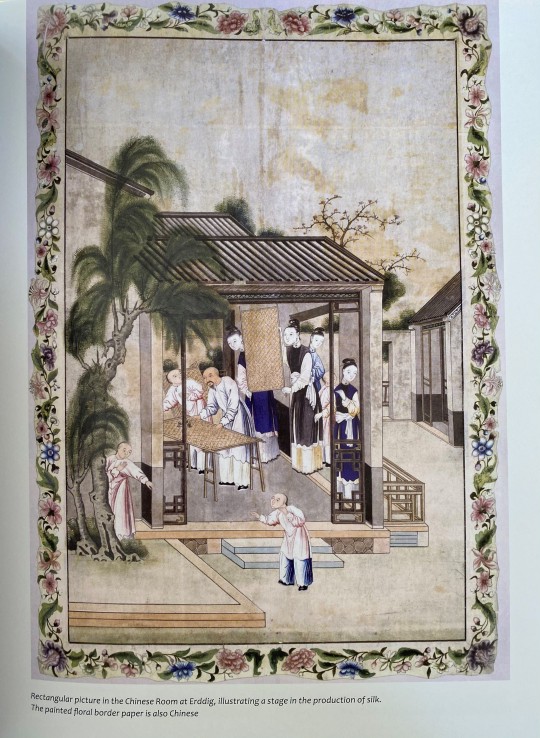
From Chinese Wallpaper, likely made in the late Qianlong era (1770s-1790s). This kind of more down to earth art illustrating everyday life is a lot more rare to see, especially those where the artist attempts Western shading or perspective.
Because “Chinese art” for most people only encompasses literati painting, calligraphy, ceramics and other such stereotypical disciplines, seeing the relative lack of them in the Qing it’s easy to jump to the conclusion that art was not produced with the same rigor as in previous dynasties, which then leads to notions about the Qing being conservative and uncultured and such. No, art was abundant in the Qing, it’s just that the popular taste in art has changed so it was often made in a different medium (oil painting, print and indeed wallpapers) using a combination of Chinese and Western techniques. Scholarship on mediums like oil painting (China trade painting) and reverse glass painting has been virtually nonexistent until very recently; the first thorough monograph of reverse glass painting I’ve read is Thierry Audric’s 2020 Chinese Reverse Glass Painting 1720-1820. I really hope that as research on Qing export art accumulates, it would be able to finally integrate itself into the wider timeline of Chinese art history. So on this matter, thank you de Bruijn for making a whole book on a niche category of Chinese art.
Underrated era
Now with the context out of the way, I can talk about fashion. Although there is no mention of fashion in the text since that isn’t what this book is about, the images included are great for illustrating fashion in the early to mid Qing, which is not well represented in the study of Chinese fashion history at all. I’ve talked multiple times about 18th century erasure on this blog, and I think this book is a very good antidote to that. The bulk of the wallpapers featuring humans were from the Qianlong era (1735-96), a personal favorite era of mine, and there are also several that depict the Jiaqing era (1796-1820), which is even rarer.
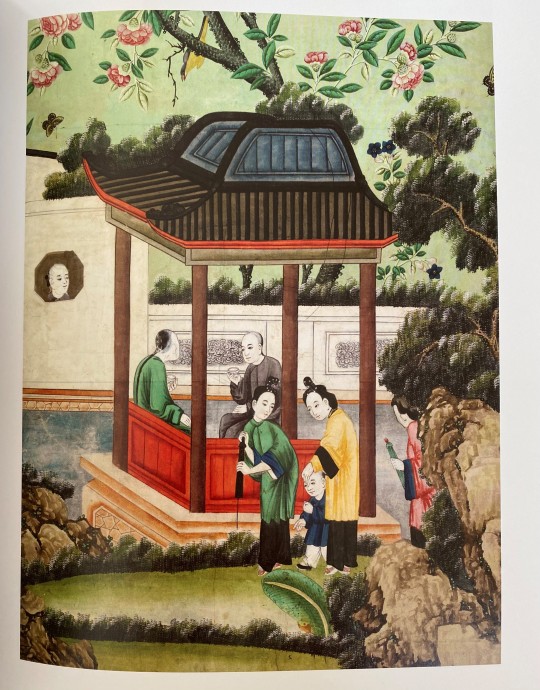
What seems to be Jiaqing era clothing. The unicolor robes with black binding paired with plain black pants or skirts have a very casual and pastoral look. The style is weirdly reminiscent of modern stereotypical “Republican era uniform” Halloween costumes, but way better.
Conclusion/rating
This is a short review because the main point is that this book has plenty of nice images of an underrated era. Without a doubt 9/10. One point off because it would be nicer if the wallpapers are dated, but that’s a minor qualm.
267 notes
·
View notes
Photo

From Indonesian traditional mask dance “Topeng Kelana”.
26 notes
·
View notes
Photo

From Indonesian traditional mask dance “Topeng Kelana”.
26 notes
·
View notes
Text
Telepathy twins
What if the things faust says (or at least some of the things) are asra's thoughts ? Cause sure she says things like friend or squeeze but it's funny to think that's it's asra who's internally going "push Lucio over the docks" or "commit crimes" or "steal that shiny cat skull" with a serene look on his face
107 notes
·
View notes
Text
💛A Hymn to Apollo💛
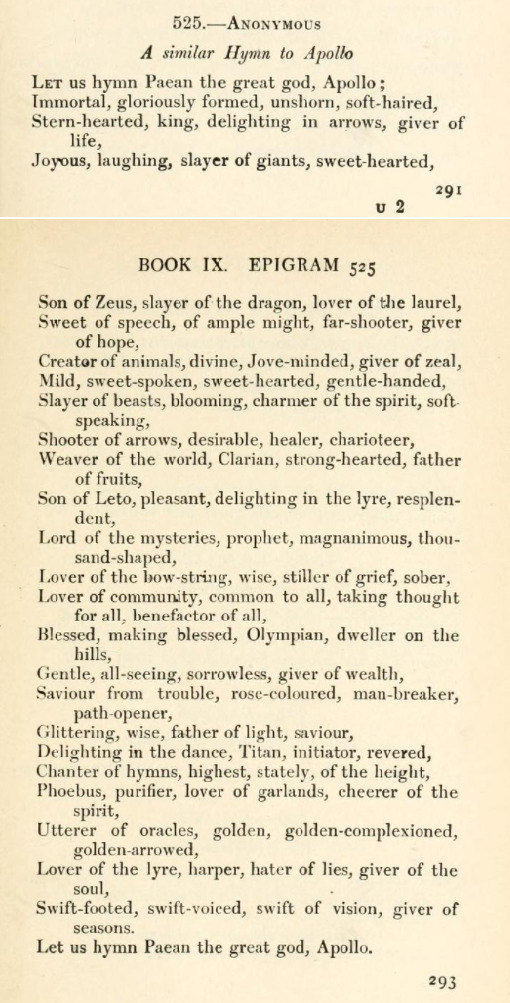
Unknown author
The Greek Anthology (ca. 100 BCE), translation by W. R. Paton

A Hymn to Apollo
Let us hymn Paean the great god, Apollo;
Immortal, gloriously formed, unshorn, soft-haired,
Stern-hearted, king, delighting in arrows, giver of life,
Joyous, laughing, slayer of giants, sweet-hearted,
Son of Zeus, slayer of the dragon, lover of the laurel,
Sweet of speech, of ample might, far-shooter, giver of hope,
Creator of animals, divine, Jove-minded, giver of zeal,
Mild, sweet-spoken, sweet-hearted, gentle-handed,
Slayer of beasts, blooming, charmer of the spirit, soft speaking,
Shooter of arrows, desirable, healer, charioteer,
Weaver of the world, Clarian, strong-hearted, father of fruits,
Son of Leto, pleasant, delighting in the lyre, resplendent,
Lord of the mysteries, prophet, magnanimous, thousand-shaped,
Lover of the bow-string, wise, stiller of grief, sober,
Lover of community, common to all, taking thought for all, benefactor of all,
Blessed, making blessed, Olympian, dweller on the hills,
Gentle, all-seeing, sorrowless, giver of wealth,
Saviour from trouble, rose-coloured, man-breaker, path-opener,
Glittering, wise, father of light, saviour,
Delighting in the dance, Titan, initiator, revered,
Chanter of hymns, highest, stately, of the height,
Phoebus, purifier, lover of garlands, cheerer of the spirit,
Utterer of oracles, golden, golden-complexioned, golden-arrowed,
Lover of the lyre, harper, hater of lies, giver of the soul,
Swift-footed, swift-voiced, swift of vision, giver of seasons.
Let us hymn Paean the great god, Apollo.

Clarian - an epithet of Apollo related to his worship in Claros; he had a large temple complex there
"Titan" - perhaps the author used this to somewhat enhance or better show Apollo's might
"Giver of the soul" [ψυχοδοτήρ] - an epithet of Apollo related to his chthonic aspects; to learn more about this see: [coming soon]
"Lord of mysteries" - we could compare this epithet to another similar one [Loxias] derived by some from his intricate and ambiguous oracles.
Paean - a song or lyric poem expressing triumph or thanksgiving. In classical antiquity, it is usually performed by a chorus; from Greek paian [παιάν].
478 notes
·
View notes
Text
Now that college students no longer have access to their libraries in the same way we used to and have to do most of our learning at home it would be just terrible if we all knew about https://1lib.eu/ a website which has books on basically every topic ever available for free including college textbooks. Imagine if people were researching their thesis without paying for it.
DO NOT USE THIS SITE AND DEFINITELY DO NOT NOT TELL YOUR FRIENDS ABOUT THIS SITE, THEY MIGHT START DOING THESIS RESEARCH FOR FREE OR JUST START READING BOOKS THEY FOUND ON THERE FOR FUN BECAUSE THEY THOUGHT THEY WERE INTERESTING. This would be terrible :( :(
Reblog to spread the word so that everyone knows to avoid this site!
63K notes
·
View notes
Photo


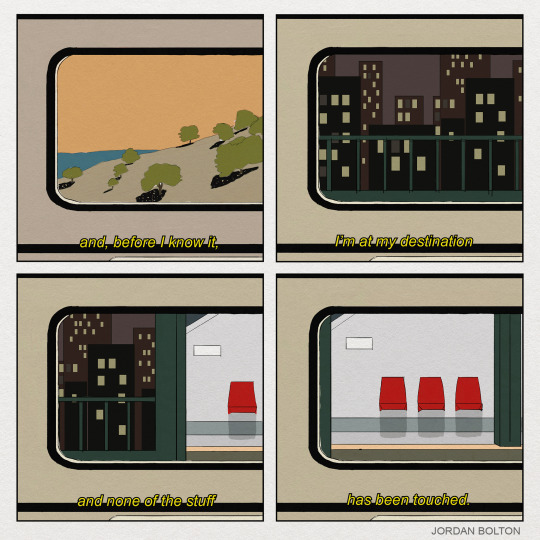
“Long Train Journeys” by Jordan Bolton
Part of “Scenes from Imagined Films” Comic
68K notes
·
View notes
Text
History and events always come full circle. Athens is america, we're still using a bunch of harmful chemicals in daily things (PFAs), fashion in general, etc. It's the same board and pieces but just different rules
2 notes
·
View notes


















